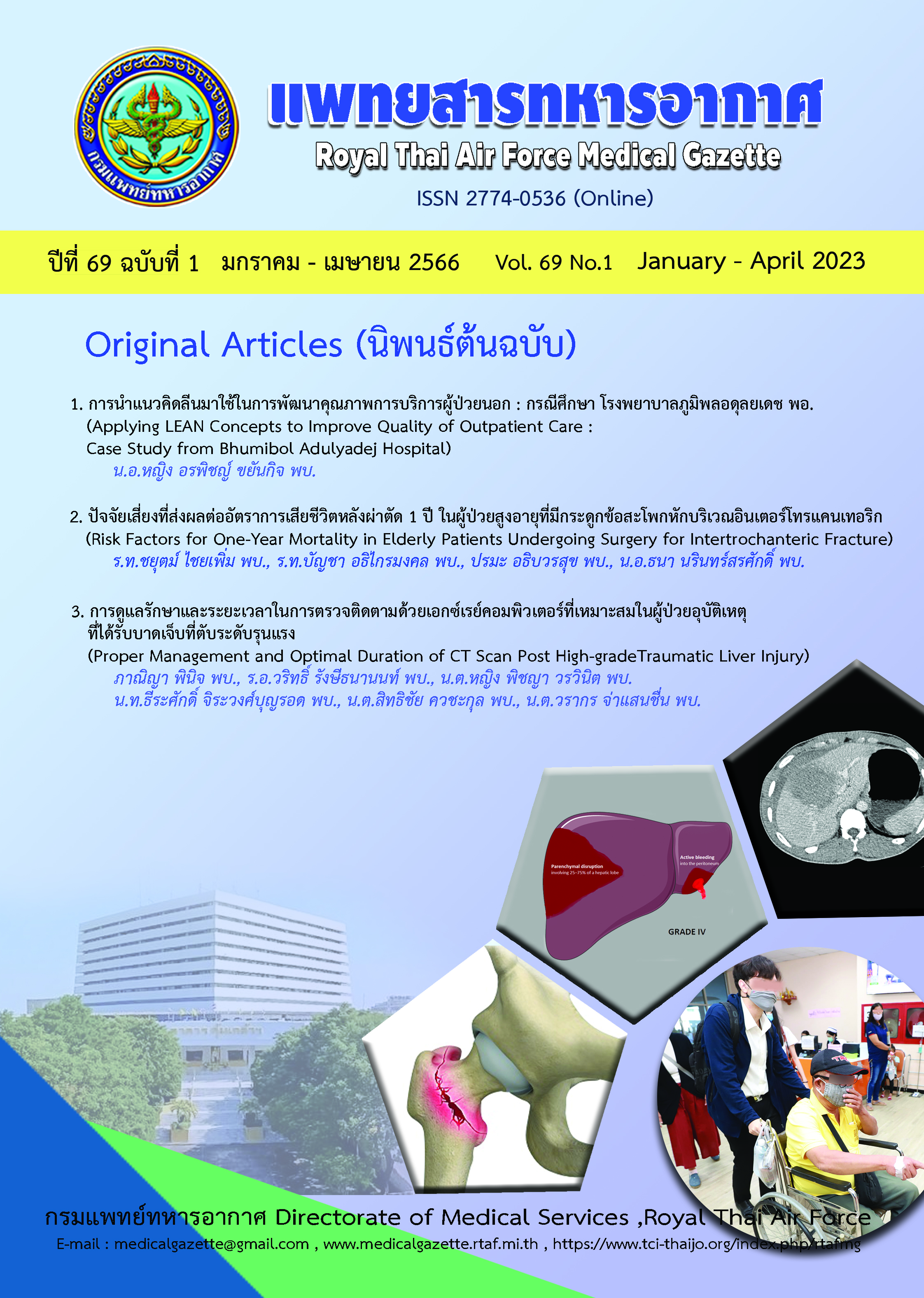The proper follow-up time to CT scan and outcome of management high-grade traumatic liver injury.
Main Article Content
Abstract
Background: Currently, there is several controversies on duration and healing rate of high-grade liver injury. The burden of non-healing liver injury affects patient’s daily living activities.
Objectives : To investigate outcome and factors associated with the resolution of traumatic liver injury at 4-week period in both low-grade and high-grade liver injury according to American Association for Surgery of Trauma (AAST) liver injury grading scale.
Methods: Medical records review was conducted on all traumatic liver injury patients admitted to Bhumibol Adulyadej Hospital from January 1st, 2014 to December 31st, 2019, and follow up abdominal contrast computerized tomography (CT) scan within 4 weeks after injury. Patient data obtained include age, gender, hematocrit, liver function test, hemodynamic stability, mechanism of injury, operative management, lengths of hospital stay and ICU stay, outcome at follow-up CT scan, and time to follow-up CT scan. Patients were classified into high-grade liver injury (grade IV-V) and low-grade liver injury (Grade I-III). The comparison of outcomes between groups was analyzed and statistical significance was set at p-value <0.05.
Results: A total of 126 traumatic liver injury patients were included. Of which, 54 (43%) were high-grade liver injury and 72 (57%) were low-grade liver injury. In overall, 68 (54%) recovered from liver injury. CT scan at 4-week found resolution of liver injury in 7% of high- grade injury compared to 89% in low-grade injury (p-value < 0.001). Factors associated with overall healing outcome included blunt mechanism (95%CI = 1.29-17.48), normal arrival hematocrit (95%CI = 1.21-10.94) and absence of any liver surgery (95%CI = 0.99-5.22).
Conclusions: CT scan is a useful modality to evaluate healing of liver injury. Resolution of high-grade injury at 4-week is low. Early transfusion may promote healing of liver injury.
Article Details

This work is licensed under a Creative Commons Attribution-NonCommercial-NoDerivatives 4.0 International License.
บทความที่ได้รับการตีพิมพฺเป็นลิขสิทธิ์ของวารสาร
References
Melloul E, Denys A, Demartines N. Management of severe blunt hepatic injury in the era of computed tomography and transarterial embolization: A systematic review and critical appraisal of the literature. J Trauma Acute Care Surg. Sep 2015;79(3):468-74. doi:10.1097/ta.0000000000000724
Afifi I, Abayazeed S, El-Menyar A, Abdelrahman H, Peralta R, Al-Thani H. Blunt liver trauma: a descriptive analysis from a level I trauma center. BMC Surg. Jun 19 2018;18(1):42. doi:10.1186/s12893-018-0369-4
Croce MA, Fabian TC, Kudsk KA, et al. AAST organ injury scale: correlation of CT-graded liver injuries and operative findings. J Trauma. Jun 1991;31(6):806-12.
Kozar RA, Crandall M, Shanmuganathan K, et al. Organ injury scaling 2018 update: Spleen, liver, and kidney. J Trauma Acute Care Surg. Dec 2018;85(6):1119-1122. doi:10.1097/ta.0000000000002058
Alghamdi HM. Management of Liver Trauma. Saudi J Med Med Sci. May-Aug 2017;5(2):104-109. doi:10.4103/1658-631x.204868
Coccolini F, Catena F, Moore EE, et al. WSES classification and guidelines for liver trauma. World J Emerg Surg. 2016;11:50. doi:10.1186/s13017-016-0105-2
Galvagno SM, Jr., Nahmias JT, Young DA. Advanced Trauma Life Support(®) Update 2019: Management and Applications for Adults and Special Populations. Anesthesiol Clin. Mar 2019;37(1):13-32. doi:10.1016/j.anclin.2018.09.009


